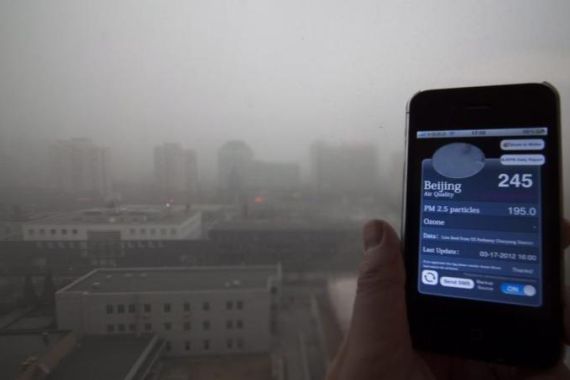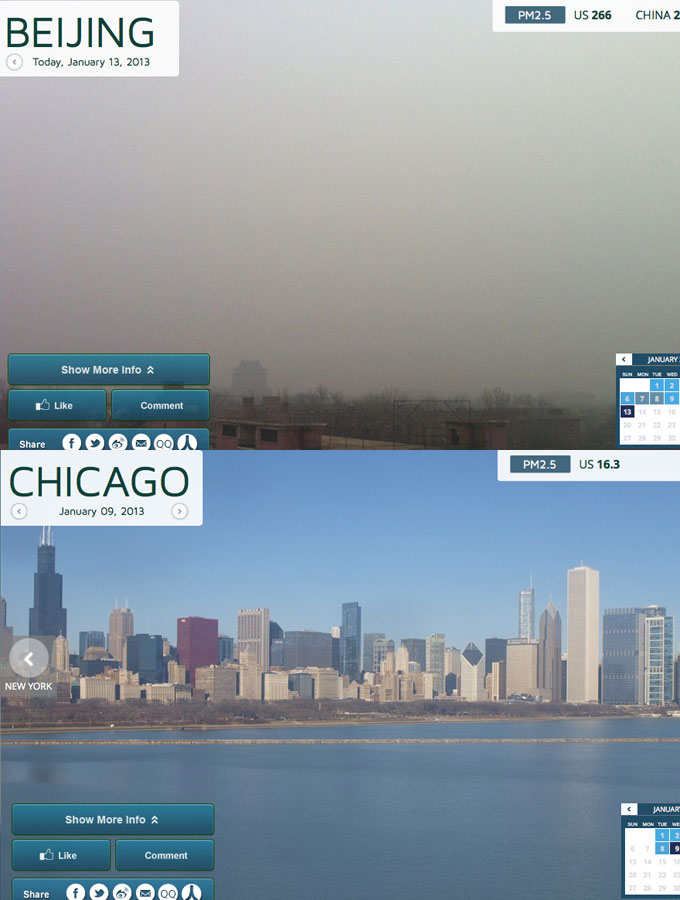Exposing the ‘hazardous’ pollution of Beijing
A lack of official data and public concern over air pollutant levels have led citizen statisticians to take action.

A thick layer of smog hangs over the skyline of Beijing; the city’s buildings are barely visible though the haze. In sharp contrast, Chicago’s skies are clear and blue, its skyscrapers almost gleaming in the bright sunlight.
 |
| A stark visual comparison of Beijing and Chicago observed by China Air Daily [chinaairdaily.com] |
These cityscapes are part of a daily collection of photos of seven cities, four in China and three in the United States published on the website China Air Daily .
The website provides a daily record of pollution levels in Chinese cities and compares them with US cities using photos, data and satellite images from NASA.
Keep reading
list of 4 itemsPhotos: Athens turns orange under North Africa’s Sahara dust clouds
Turtles swimming to extinction in Malaysia as male hatchlings feel heat
Could shipping containers be the answer to Ghana’s housing crisis?
The idea for the website “came from a simple idea that taking a picture every day is a direct way of seeing what the pollution looks like”, its founder, Michael Zhao, told Al Jazeera.
“If you look at the pictures of Beijing, at some times of the year the air pollution is really bad. That is basically the idea of talking about air pollution through the medium of these pictures,” he said.
Air pollution levels soared in a number of Chinese cities this weekend with air quality in the capital Beijing being described as hazardous. The city’s authorities urged residents, especially the elderly, children and those suffering from respiratory and cardiovascular diseases to stay indoors.
On Saturday, the US embassy in Beijing, which monitors air quality from its rooftop and publishes pollution levels on a Twitter feed, described the pollution levels as “beyond index”.
Last month, Zhao Hualin, head of the Ministry of Environmental Protection Department of Pollution Prevention and Control said that 70 percent of Chinese cities fail to meet new air quality standards introduced by the Chinese government.
The Beijing municipal government also published emergency interim proposals for tackling air pollution after more than 200 heavily polluted days were registered in the city by the Air Quality Index.
Two recent studies point to the health dangers and economic costs of air pollution in China. The first, in the Lancet medical journal found that air pollution, especially fine particulate matter such as soot, contributes to more than 3.2m premature deaths worldwide each year, with most of these deaths occurring in China and other Asian countries.
Another study, carried out by Greenpeace East Asia and Peking University’s School of Public Health estimated that air pollution was the cause of 8,572 premature deaths in four major Chinese cities, and resulted in a total of $1.08bn in economic losses in 2012.
Dangerous particulates
The Greenpeace study focused on the impact of fine particulate pollution known as PM2.5, which is considered the most dangerous, as the fine particulates lodge deep within the lungs and enter the bloodstream.
Researchers found that if the cities of Shanghai, Guangzhou, Xi’an and Beijing lowered their PM2.5 levels to meet the World Health Organisation’s Air Quality Guidelines , the number of premature deaths would be reduced by at least 81 percent and the economic losses for the four cities could be reduced by $868m.
|
‘Dangerous’ pollution levels choke Beijing |
Professor Pan Xiaochuan, who was involved in the research for the report, explained the causes of this type of pollution. “Generally I think the PM2.5 is coming from the vehicles in most of the big cities in China,” he said. “It is also from the burning of coal from power stations.”
Michael Zhao is based in the United States and notices the difference in air quality when he flies to Beijing. “The contrast immediately registers with you,” he said. “When you stay in Beijing for a couple of days, you feel something in your throat that bothers you and tells you something is different and you can see that the air is smoggy.”
When he was in Beijing “you couldn’t see the sky for many days. For the people living there all their lives it is even worse. I got to talk to people there about air pollution.” This was a motivation for the website which he publishes as part of his work with the Asia Society .
“One day I saw a NASA comparison image of a good day and a bad day from satellites and you can see from space the difference in smog levels two days apart. I got in touch with NASA and they agreed to give us use of their images of China and also several US cities as well and we got in touch with people who have good views in these cities,” he said.
Michael believes his website is the only one in the world to document air pollution in this way. “I know there are sites that deal with scientific data and sometimes they draw on satellite images, but in terms of a consistent day-to-day record of air quality with pictures, I think we are the only one.”
In recent years, the high levels of air pollution in Chinese cities – particularly in Beijing – has led to public outcry and calls for the government to publish accurate data.
Until recently, China’s official air quality monitoring system did not publish adequate figures and only measured large particles in the air, not the smaller PM2.5 particles.
The lack of official data and public concern over air pollution levels led to a number of people taking action themselves. In 2011 a group of environmental activists purchased their own air quality monitor and posted the readings online.
Air quality in real-time
A number of smartphone applications that give air quality measurements have been developed and become very popular with people checking information on air quality in real-time. One such application was developed by a company called Fresh Ideas Studio . Their application collects data on air pollution from several sources and has had 800,000 downloads.
While they started with a Beijing version, they also now have an application for over 120 cities. “November (2011) we just started a venture in the field of mobile internet, at that time the air quality was becoming a public issue, so we decided to build an app about it,” Wang Jun of Fresh Ideas Studio told Al Jazeera.
|
“What are the sources of pollution in these cities and how do you address the problem? … I don’t think the government has gotten a handle on that or a solution that they can put in place soon.” – Michael Zhao, China Air Daily |
“PM2.5 can increase the risk of illness, of respiratory diseases, and in the meantime more and more people living in China began to be concerned about environmental protection, so its becoming important to let people know information about the PM2.5.”
The US embassy in China has, for the past two years, measured air quality levels on its rooftop and publishes the results throughout the day on Twitter.
The figures can make for stark reading and in 2010, the embassy’s Twitter feed for Beijing described the air quality as “crazy bad” after its air monitor registered a reading in excess of 500 micrograms of PM2.5 per cubic metre for the first time.
This level has occurred on a number of other occasions since then. The Chinese government initially called on foreign missions to stop publishing “inaccurate and unlawful” data, but has since bowed to public pressure and has begun measuring and publishing PM2.5 levels in Beijing.
Steven Q Andrews, an environmental and legal consultant based in Beijing, said the move to measure and publish the PM2.5 levels was a welcome one – but issues still remain.
“One is how accurate is the data that is being reported,” he said. “And the other is how the data that is being described to the public. This issue is still continuing with bad levels being called excellent air quality.”
“The descriptions are far different from those the World Health Organisation or the US Environmental Protection Agency would use. That is part of the reason the US embassy monitor had such a big impact.”
While the data has improved, the next challenge for the Chinese government is to improve the levels of air pollution.
With much of China’s economic boom powered by coal, this will be a challenge. In December, the Chinese Ministry of Environmental Protection released a plan for reducing air pollution and said that officials aim to cut PM2.5 levels by at least five percent by 2015 in 13 areas, covering 117 cities.
“I think in terms of the volume of data provided, it is getting to a level that is quite good. But then the question is: What are the sources of pollution in these cities and how do you address the problem? That is, longer term, the really hard part,” said Michael Zhao.
“I don’t think the government has gotten a handle on that or a solution that they can put in place soon. As China continues to grow, it relies on coal to power the economy. I don’t think there is a short-term solution.”
Follow Jennifer Duggan on Twitter: @jenniduggan
Click through this gallery for more photos of China’s polluted cities.